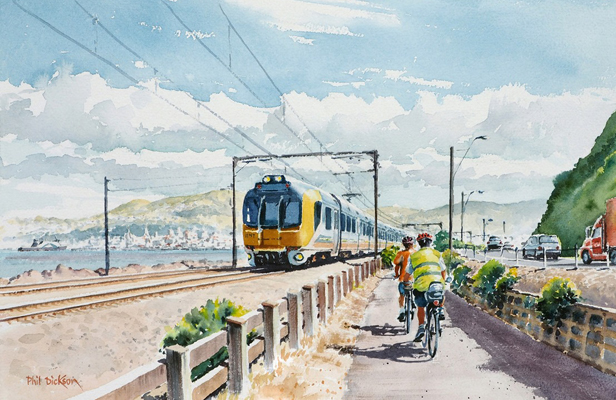
Phil Dickson has rambled Wellington and climbed its surrounding hills since he was a small boy growing up in the Hutt Valley. A predilection for art and geography led him to be a cartographer – “the saying goes there is ‘art’ in cartography,” he says – and now he has produced a very personal book of art, including maps, evocative of his 69-year love affair with his city.
Dickson’s sketches and oil and watercolour paintings cover the oddly familiar in Wellington – Sunday in Bowen St, a morning view from Thompson St, the Hutt Rd cycleway with a lonely couple of cyclists and a passing train, Brooklyn Galleria with the Penthouse Cinema in the background, a wet day in Aro St, the city and harbour from Brooklyn on a winter afternoon, a couple of lady artists sketching tulips in the sun in the Botanic Garden.
They are everyday scenes barely recorded in passing by long-term Wellingtonians. Dickson says he sees them as “taking joy from the ordinary”.
Slightly further afield he pictures trampers on the skyline walkway, and scenes from the Hutt Valley, the Rimutaka Range and the Orongorongo River valley, rambling places that he knows well and that fit his personal version of “greater Wellington”.
Wellington, he says, its geography, and even its weather, has always been of more interest to him than any other part of the world. “A lot of people I know do lots of overseas trips but they’re geographically illiterate of their own land.”
His tramps, which began when he was a Scout, have taken him on only a few of the South Island’s tourist- pitched tracks, “because they’re not me”. The Orongorongo Valley, the Tararua Range and Wellington’s city peaks have always been more important. Every day for 50 years or so he has kept a record of Wellington’s weather, “keeping an eye on my own backyard.”
Not for him trying to chart global warming or chasing overseas thunderstorms – “just day-to-day weather, though I can see trends, watching it year after year”.
Dickson could have chosen art over cartography as a career but, although he had been drawing since he was a toddler, he chose the practical. Dickson worked for the government mapping agency, the then Department of Lands and Survey.
Anyway, he says, an understanding of graphic art is conducive to a nice map and his job required him to make forays into the open air, “field checking”. This included checking urban walkways.
In Wellington, he’s wandered these walkways, many of which are no longer mapped.
“As a city, Wellington is so steep and so many streets are interconnected with other streets. It’s too expensive to do, putting people on the ground. A lot are picked up from previous editions. You can pick up a lot from Google maps if you zoom in enough.”
Dickson never formally studied fine art, though “I’ve done a few art courses and run a few over the years”. Aspects of art, like perspective, can be taught, he believes, “but inspiration is very personal”. He is an elected artist member of the New Zealand Academy of Fine Arts, was a recent guest artist at a Watercolour New Zealand national exhibition, and belongs to the Wellington Art Club.
Ad Feedback
He often walks to the club’s Miramar base from his Brooklyn home. “Walking is my wife’s and my default mode of travel.”
These days he does much of his painting in his studio.
“I did a lot of painting plein air, outdoors, when I was younger, and for a long time found it difficult painting in a studio without the inspiration on the spot.”
For years he contemplated the idea of a book of his paintings “but never had the confidence”.
His only writing experience was club newsletters.
His encouragement came from Wellington publisher Graham Stewart, who had bought one of his paintings and shares his love of Wellington’s history, particularly its transport history.
– Phil Dickson’s Wellington (Grantham House Publishing, $45) is released this month. The book will be launched at Wellington’s CQ Hotel on August 20.
– The Dominion Post